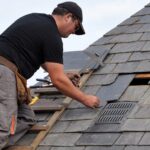Roof rats, also known as black rats or ship rats, are a common pest that can pose serious threats to homeowners. These agile rodents can easily enter homes through roofs, attics, and other entry points. Knowing how to spot the signs of an infestation and take appropriate steps to prevent them is crucial for maintaining a safe and pest-free environment.
Understanding the habits of roof rats is essential for effective prevention and control. They are primarily active at night and prefer to nest in elevated places, which makes attics and roofs the perfect hideouts. They can gain entry through small openings in the roof or walls.

How Do Roof Rats Enter Homes?
Roof rats are known for their remarkable climbing skills. They can scale walls, climb trees, and even balance on utility lines. Any small opening in your home’s exterior, like gaps in siding or cracks around windows, can serve as an entry point. It is crucial to seal these gaps using materials like steel wool or caulk.
Signs of Roof Rat Infestations
Recognizing the signs of a roof rat infestation early can help in taking timely action. Look for signs such as droppings, gnaw marks, and grease trails along walls. If you hear scratching or scurrying noises in the attic or ceiling, you might have roof rats in your house.
Droppings
Roof rat droppings are a telltale sign of their presence; they are elongated and pointed at the ends. Finding these around your home, especially in attics and on roofs, is a sign of an infestation.
Gnaw Marks
These pests need to constantly gnaw to keep their teeth in check. Look for gnaw marks on wooden structures, electric wires, and cables. These marks are typically small and irregular.
Grease Trails
Roof rats leave dark, greasy marks along the paths they travel. These trails can be found on walls, floors, and ceilings.
Preventing Roof Rat Infestations
Prevention is the best strategy when it comes to roof rats. Here are some tips to keep them at bay:
- Seal Entry Points: Use hardware cloth, steel wool, or caulk to seal any openings in your home’s exterior.
- Trim Trees: Keep trees and shrubs trimmed away from your roof to prevent rats from using them as ladders.
- Eliminate Food Sources: Store food in airtight containers, and keep pet food and birdseed sealed.
- Maintain Cleanliness: Regularly clean and declutter your attic, garage, and storage areas.
Effective Roof Rat Control Methods
If roof rats have already made their way into your home, it is essential to take immediate action to eliminate them. Here are some effective control methods:
Traps
Using traps is a common method for controlling roof rats. Snap traps, glue traps, and electronic traps are available options. It is important to place these traps along the rats’ pathways for maximum effectiveness.
Poisons
Rat poisons can be effective, but they should be used with caution, especially in homes with pets and children. It is recommended to hire a professional pest control service to use this method safely.
Professional Pest Control Services
If the infestation is severe, it may be best to call in professionals. Pest control experts can assess the situation and implement appropriate measures.

FAQs About Roof Rats
How can I tell if I have roof rats in my house?
Look for signs such as droppings, gnaw marks, and grease trails. Also, listen for noises in the attic or walls at night.
What should I do if I find a roof rat in my house?
Set traps or call a professional pest control service to eliminate the infestation. Ensure to also seal any entry points to prevent future infestations.
Are roof rats dangerous?
Yes, roof rats can pose health risks as they are known to carry diseases. They can also cause damage to your home by gnawing on structures and wiring.
For more detailed information on the cost implications of roof-related pests, visit Roof Costs.
This article contains affiliate links. We may earn a commission at no extra cost to you.








